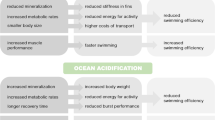Abstract
Synchrony among Atlantic spotted dolphins (Stenella frontalis) is crucial for successfully overcoming bottlenose dolphins (Tursiops truncatus) during interspecies aggression (Cusick and Herzing 2014). The present study examined synchrony in adult Atlantic spotted dolphins during aggressive encounters with bottlenose dolphins. Across group size, aggressive behaviors increased preceding synchrony, peaked during synchrony, and decreased dramatically after synchrony. Although smaller groups (< 10 dolphins) became synchronous more frequently than larger groups (> 10 dolphins), larger groups remained synchronous longer; however, smaller groups exhibited greater aggressive behaviors during synchrony, suggesting that additional aggressive behaviors may be necessary to compensate for the smaller group size, whereas larger groups may be able to rely on synchrony with less aggression. Disorganized squawk bouts synchronized as physical synchrony began, but only if coupled with escalating aggression.

Similar content being viewed by others
References
Arnott G, Elwood RW (2009) Assessment of fighting ability in animal contests. Anim Behav 77:991–1004
Backwell PRY, Jennions MD, Christy JH, Passmore NI (1999) Female choice in the synchronously waving fiddler crab (Uca annulipes). Ethology 105:415–421
Bel’Kovich VM, Agafonov AV, Yefremenkova OV, Kozarovitsky LB, Kharitonov SP (1991) Herd structure, hunting, and play: bottlenose dolphins in the Black Sea. In: Pryor K, Norris K (eds) Dolphin societies: discoveries and puzzles. Univ. of California Press, Berkeley, pp 17–78
Boesch C (2002) Cooperative hunting roles among tai chimpanzees. Hum Nat 13:27–46
Buck JB (1938) Synchronous rhythmic flashing of fireflies. Q Rev Biol 13:301–314
Connor RC, Smolker R, Bejder L (2006) Synchrony, social behaviour and alliance affiliation in Indian Ocean bottlenose dolphins Tursiops aduncus. Anim Behav 72:1371–1378
Crespi BJ (1986) Size assessment and alternative fighting tactics in Elaphrothrips tuberculatus (Insecta: Thysanoptera). Anim Behav 34:1324–1335
Cusick JA, Herzing DL (2014) The dynamic of aggression: how individual and group factors affect the long-term interspecific aggression between two sympatric species of dolphin. Ethology 120:287–303
Eibl-Eibesfeldt I (1966) The fighting behaviour of marine iguanas. Philos Trans R Soc Ser B Biol Sci 251:475–476
Ewald PW (1985) Influence of asymmetries in resource quality and age on aggression and dominance in black-chinned hummingbirds. Anim Behav 33:705–719
Fedurek P, Machanda ZP, Schel AM, Slocombe KE (2013) Pant hoot chorusing and social bonds in male chimpanzees. Anim Behav 86:189–196
Fellner W (2000) Synchrony between a mother-calf pair of bottlenose dolphins Tursiops truncatus. University of South Florida, Dissertation
Fellner W, Bauer GB, Stamper SA, Losch BA, Dahood A (2012) The development of synchronous movement by bottlenose dolphins (Tursiops truncatus). Mar Mamm Sci 29:E203–E225
Hagen EH, Bryant GA (2003) Music and dance as a coalition signaling system. Hum Nat 14:21–51
Herzing DL (1996) Vocalizations and associated underwater behavior of free-ranging Atlantic spotted dolphins, Stenella frontalis, and bottlenose dolphins, Tursiops truncatus. Aquat Mamm 22:61–80
Herzing DL (1997) The life history of free-ranging Atlantic spotted dolphins (Stenella frontalis): age classes, color phases, and female reproduction. Mar Mamm Sci 13:576–595
Herzing DL (2015) Synchronous and rhythmic vocalizations and correlated underwater behavior of free-ranging Atlantic spotted dolphins (Stenella frontalis) and bottlenose dolphins (Tursiops truncatus) in the Bahamas. Animal Behavior and Cognition 2:14–29
Herzing DL, Johnson CM (2015) Dolphin communication and cognition: past, present, and future. MIT Press, Cambridge
Herzing DL, Moewe K, Brunnick BJ (2003) Interspecies interactions between Atlantic spotted dolphins, Stenella frontalis, and bottlenose dolphins, Tursiops truncatus, on great Bahama Bank, Bahamas. Aquat Mamm 29:335–341
Kuczaj SA II, Winship KA, Eskelinen HC (2015) Can bottlenose dolphins (Tursiops truncatus) cooperate when solving a novel task? Anim Cogn 18:543–550
McBride AF, Hebb DO (1948) Behavior of the captive bottlenose dolphin, (Tursiops truncatus). J Comp Physiol Psych 41:111–123
Mech LD (2007) Annual arctic wolf pack size related to arctic hare numbers. Arctic 60:309–311
Mech LD, Boitani L (2003) Wolves: behavior, ecology, and conservation. Univ. of Chicago Press, Chicago, IL
Narins PM (1983) Synchronous vocal response mediated by the amphibian papilla in a neotropical treefrog: behavioural evidence. J Exp Biol 105:95–105
Norris KS, Dohl TP (1980) The structure and function of cetacean schools. In: Herman LM (ed) Cetacean behavior: mechanisms and functions. Wiley, New York, pp 211–261
Norris KS, Schilt CR (1988) Cooperative societies in three-dimensional space: on the origins of aggregations, flocks, and schools, with special reference to dolphins and fish. Ethol Sociobiol 9:149–179
Nuechterlein GL, Storer RW (1982) The pair-formation displays of the western grebe. Condor 84:351–369
Pitcher TJ, Parrish JK (1993) Functions of shoaling behaviour in teleosts. In: Pitcher TJ (ed) Behaviour of teleost fishes. Chapman and Hall, London, pp 363–439
Sicotte P (1993) Inter-group encounters and female transfer in mountain gorillas: influence of group composition on male behavior. Am J of Primatol 30:21–36
Similä T (1997) Sonar observations of killer whales (Orcinus orca) feeding on herring schools. Aquat Mamm 23:119–126
Volker CL (2016) Aggressive behaviors of adult male Atlantic spotted dolphins (Stenella frontalis) during intraspecific and interspecific aggressive interactions. Florida Atlantic University, Master’s Thesis
Acknowledgements
This research was conducted with the Wild Dolphin Project in the Bahamas under Bahamian Department of Fisheries permits. Thank you to Dr. I. Johanson. Thank you to C. Volker for serving as second observer, to B. Augliere, and N. Skrzypczak. Thank you to the Wild Dolphin Project researchers, crew, and supporters.
Author information
Authors and Affiliations
Corresponding author
Rights and permissions
About this article
Cite this article
Myers, A.J., Herzing, D.L. & Bjorklund, D.F. Synchrony during aggression in adult male Atlantic spotted dolphins (Stenella frontalis) . acta ethol 20, 175–185 (2017). https://doi.org/10.1007/s10211-017-0262-7
Received:
Revised:
Accepted:
Published:
Issue Date:
DOI: https://doi.org/10.1007/s10211-017-0262-7




